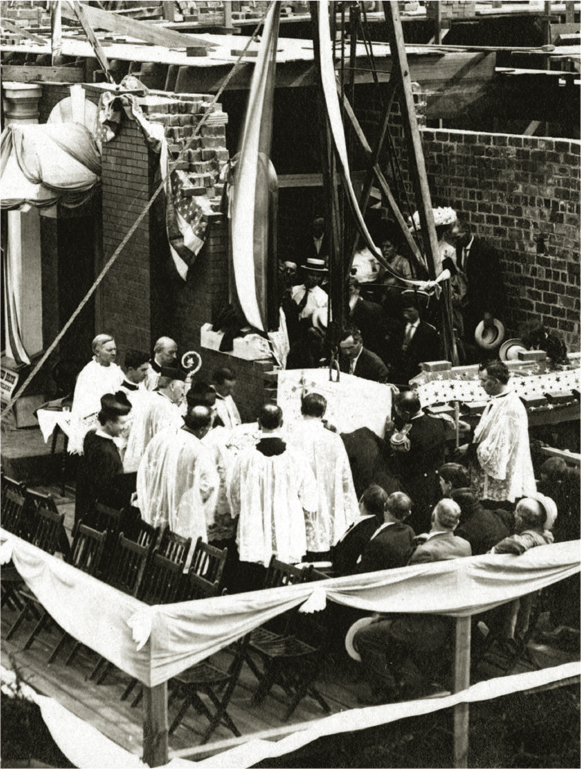
DEDICATION
THE SACRED LANDMARKS SERIESLaura Wertheimer, EditorMichael J. Tevesz, Founding Editor Revelations: Photographs of Clevelands African American Churches MICHAEL STEPHEN LEVY Resplendent Faith: Liturgical Treasuries of the Middle Ages STEPHEN N. FLIEGEL Seeking the Sacred in Contemporary Religious Architecture DOUGLAS R. HOFFMAN Eric Mendelsohns Park Synagogue: Architecture and Community WALTER C. LEEDY JR. EDITED BY SARA JANE PEARMAN A Higher Contemplation: Sacred Meaning in the Christian Art of the Middle Ages STEPHEN N.
FLIEGEL Dedication: The Work of William P. Ginther, Ecclesiastical Architect ANTHONY J. VALLERIANO The Sacred Landmarks series includes both works of scholarship and general-interest titles that preserve the history and increase understanding of religious sites, structures, and organizations in northeast Ohio, the United States, and around the world.
DEDICATION
THE WORK OF
WILLIAM P. GINTHER
ECCLESIASTICAL ARCHITECT

ANTHONY J.

Published in cooperation with Cleveland State Universitys College of Liberal Arts and Social Sciences Cataloging information for this title is available at the Library of Congress. 16 15 14 13 12 5 4 3 2 1 No praise of the architect of St. 16 15 14 13 12 5 4 3 2 1 No praise of the architect of St.
Columbas,
Mr. W.P. Ginther of Akron, could express half so much
as does the building itself. It is a monument to a rare artistic skill
and will carry his name and fame to future generations. He has achieved a reputation
as a builder of churches which embody all that is best
in ecclesiastical architecture.  Catholic Universe Bulletin
Catholic Universe Bulletin
On the dedication of the new St.
Columbas Catholic Church
in Youngstown, Ohio
Catholic Diocese of Cleveland
July 3, 1903  LAYING OF THE CORNERSTONE St. Pauls Catholic Church, North Canton, Ohio
LAYING OF THE CORNERSTONE St. Pauls Catholic Church, North Canton, Ohio 
CONTENTS

WILLIAM P. GINTHER ECCLESIASTICAL ARCHITECT
Ohio Architect, Engineer and Builder 20, no. 6 (Dec. 1912): 16.

Therefore, when we build, let us think that we build forever.
Let it not be for present delight, nor for present use alone; let it be such work as our descendants will thank us for, and let us think, as we lay stone on stone, that a time is to come when those stones will be held sacred because our hands have touched them, and that men will say as they look upon the labour and wrought substance of them, See! this our fathers did for us.
John Ruskin For more than a hundred years, in small towns throughout Ohio and Pennsylvania, thousands of people have come together at the most significant moments of their lives to worship, celebrate, commemorate, mourn, teach, study, and even cure in buildings that at one time started as a creative idea in one mans mind: architect William P. Ginther. I first became aware of Ginthers work in the early 1970s when, in Ashtabula, Ohio, I attended the Mother of Sorrows Catholic Church and grade school. As any Catholic schoolchild will tell you, you spend a lot of time in church! For some, it was a chore. For me, however, it was a chance to study this wondrous and graceful interior of interlocking and dancing arches and domes and its castle-like exterior of rough-cut sandstone and beacon-like bell tower. Mother of Sorrows was dedicated in the late 1900s during a time of great immigration to the United States.
As was the case across the country, many of the immigrants who settled in Ashtabula were skilled laborers and craftsmen, and they made this new community their home by building a church that communicated, without words, grandeur and reverence in arches, domes, and stones. My parents owned a commemorative book on Mother of Sorrows that I studied for hours, one image in particular holding my attention: a 2-by-3-inch photo that, even though too small to reveal details, showed a vastly different interior from the simple one I knew. It wasnt until 2003 that I saw a much larger and detailed image of the original church interior and a picture of its architect, thus marking the beginning of my study of William P. Ginther and his work. William P. Ginther was born on March 21, 1858, in Akron, Ohio, to Stephen and Anna (Horning) Ginther, who had migrated from Germany to Cleveland before finally settling in Akron, where Stephen, a highly skilled merchant tailor, opened his own shop.
As a child, Ginther drew constantly and demonstrated considerable skill. In grade school he was charged with illustrating the blackboards with pictures of the school and grounds for parent-teacher meetings. As his skills advanced, he was encouraged by friends to study architecture. Indeed, his talent and skill led him to his first architecture job. At age eighteen, while attending Buchtel College (now the University of Akron), Ginther worked at a local department store. One day he was sketching a valentine for a young lady hed met at a church function when Frank O.
Weary, Akrons leading architect of the day, walked in. Spotting the drawing Ginther had hastily pushed aside, Weary curtly asked, Did you do that? Ginther replied that he had. Weary said, Come with me and escorted him to his offices upstairs and promptly put him to work. Later, in an article that ran in the Akron Sunday Times in 1932, Ginther recounted this story and attributed his great success in the field of ecclesiastical architecture to his ability to paint a good picture. Frank O. Weary was a major force in Midwest architecture in the late 1800s and early 1900s.
After finishing his advanced education in Boston in 187071, Weary spent three years in Chicago helping rebuild the city after the Great Fire before returning to Akron to start up his own firm. The firm of Weary and Kramer designed many of Ohios courthouses, churches, and business blocks in the characteristic massive stone style used for civic buildings of the time. It was at Wearys office that Ginther learned the craft of architectural drafting and engineering. After working with Weary for nearly seven years, Ginther was charged with coming up with a design for a project Weary was competing for, the First Methodist Episcopal Church in Canton, Ohio. Ginther created a sketch of his concept, and Weary presented it to the congregation, which received it with great excitement. The congregation awarded the commission to Weary, and Ginther was charged with supervising the construction of the church, which was completed in 1883.
In 1889, near the end of his employment with Weary, Ginther embarked on a tour of Europe to witness the great architectural wonders in Rome, Milan, Paris, Venice, Florence, London, Berlin, and Vienna, among other cities. This intense study, coupled with his valuable work experience with Wearys firm, provided Ginther with the necessary skills and confidence to start his own architectural firm and win a bid on a church design of his very own, St. Mary Catholic Church in Norwalk, Ohio. Also during this time period, on September 20, 1892, Ginther married Emma Wohlwend. Together they had four children, three of whom died at early ages; Ira lived only two-and-a-half years, William died at age four, and Julian died at age ten in a bicycling accident. Their only surviving child, a daughter, Mary, attended St.
Next page











 ANTHONY J.
ANTHONY J.  Published in cooperation with Cleveland State Universitys College of Liberal Arts and Social Sciences Cataloging information for this title is available at the Library of Congress. 16 15 14 13 12 5 4 3 2 1 No praise of the architect of St. 16 15 14 13 12 5 4 3 2 1 No praise of the architect of St.
Published in cooperation with Cleveland State Universitys College of Liberal Arts and Social Sciences Cataloging information for this title is available at the Library of Congress. 16 15 14 13 12 5 4 3 2 1 No praise of the architect of St. 16 15 14 13 12 5 4 3 2 1 No praise of the architect of St.  LAYING OF THE CORNERSTONE St. Pauls Catholic Church, North Canton, Ohio
LAYING OF THE CORNERSTONE St. Pauls Catholic Church, North Canton, Ohio  WILLIAM P. GINTHER ECCLESIASTICAL ARCHITECT
WILLIAM P. GINTHER ECCLESIASTICAL ARCHITECT